|
Journal of a Sabbatical |
|||||||
|
China Trip 2000 |
|
the potala |
|||||
|
|
|
|
|||||
|
Today's Reading: The Story of the Stone (a.k.a. Dream of the Red Chamber) by Cao Xuequin Some Potala Links: China Guides: The Potala The Potala Palace - from tibettrip.com The Potala - from Everest Trekking Lhasa, The Potala, other attractions - from warriortours.com |
|
I knew you needed oxygen to climb Mt. Everest but to climb the stairs in the Potala? People are carrying these blue pillows with clear plastic hoses attached. It took me awhile to figure out they contained oxygen. Needless to say, we hadn't outfitted ourselves with blue oxygen pillows. Fortunately, tour groups (as opposed to pilgrims) are
brought by bus up Red Hill to enter the Red Palace at the
western end. Our driver, Jamba, drove us up the hill past
the pilgrims and butter sellers. The road up the hill is
lined with stalls selling yak butter for the butter lamps.
Enormous chunks of yak butter. Occasionally we'd see people
carrying plastic sacks of butter about the same
size The other thing I noticed on the way up was tufts of yak hair tied to the shrubs and trees. It looked kind of like the yak had just rubbed against the branch and left the hair, but in reality it was placed there by pilgrims. It was tempting to take a tuft as a souvenir, but I didn't want to risk causing some kind of cultural offense. Once at the entrance, we moved through the zillion rooms full of zillions of art treasures and zillions of people, almost all of whom were Chinese, in the prescribed clockwise direction. Still suffering from the altitude, I struggled quiet a bit with the stairs as some of them were really steep, more like the ladders between decks of a ship than between floors of a high-rise. The stairs are pretty narrow too. An invading army would have had to storm the inner precincts of the palace single file. I imagine that would have slowed them down a lot.
Already dizzy from the altitude I got even more so from the whirl of gallery after gallery of religious images in bright colors in dim light. The experience is almost surreal. Especially with the huge crowds on a long holiday weekend. The crowd was so dense at the meditation cave of Songtsen Gampo, that people started pushing each other. Rosalie had already fled the crowd, and I followed suit. Carol and George actually stuck it out and got to see the cave. Meanwhile, I contemplated the yellow dogs sleeping in the sun on one of the roofs. There are a lot of dogs in Lhasa. Photography inside the Potala is either not allowed or allowed only with payment of a huge fee (from 50 to 90 Yuan depending on which chapel or gallery) and it's not a one time fee. It's a separate fee paid to a separate monk (if they really are monks - sometimes they seemed more like museum guards) for every room. That can add up. Hence I took no pictures inside. It's just as well. I would have gone crazy trying to photograph every statue, funerary stupa, mural, and mandala in the place. Every time I would think I'd seen the best most beautiful statue of Avalokiteshvara, there'd be a more beautiful one around the corner. Just when I thought I'd seen all the "god of longevity" statues, there'd be more. George was very good on explaining who was who in all the images. He pronounced "longevity" and "Tsongkhapa" so they both sounded like "John Denver". And I can still hear George's voice telling us over and over how Padmasambhava "spread the religion wide and deep".
The whole feeling of the Potala is a little strange. It's not just the lamas pulling cellphones out from deep in their robes, or the little panda shaped trash cans identical to the panda shaped trash cans in all the museums and tourist sites of China. It's not the funerary stupas of Dalai Lamas numbers 3 thru 13 (Rosalie asked George if the 14th Dalai Lama would be buried here and he looked very confused and answered "He's alive and well and living in India." Points to Rosalie for bringing up His Holiness in spite of all the warnings we'd gotten about that. Points to George for dodging the question effectively.) The strangeness comes from the fact that although the place is jam-packed with people, nothing happens here. It's not a seat of government or of religion. It's a museum of a once-great culture. That's an eerie feeling and added to the surreal aspect of the whole experience. Of course maybe it is just the altitude and the lamas with cellphones. Anyway, the red part of the palace is the former living
quarters and the white part contains the galleries and
chapels and stuff like that. We wound our way through
We emerged onto the roof by this staircase with the
middle part roped off. The middle stairs are only used by
the Dalai Lama (who of course doesn't live here anymore). In
the area at the foot of the stairs two groups of workers,
one all men and the other all women, were tamping down newly
applied cement. They sing a cement stomping song and tamp
and stomp in rhythm. First one group, then the other in
alternation. They thought it very strange that I wanted to
take their pictures while they were working and they laughed
at me. I found out later that Tibetans don't like to be
photographed at work. Anyway, the stuff they were repaving
the roof with is some special kind I guess the cement stomping is part of the ongoing renovations to the Potala. The Chinese government has spent millions of dollars (I forget how much George told us it was in Yuan but it comes to nearly 5 million in US dollars) on renovations. The thirteenth Dalai Lama had done some renovation work in the early 20th century, but the major renovations by the Chinese government were completed in the mid-1990's. The place is in remarkably good shape for a building that was begun in the 7th century and completed in the 17th. Part of the path on the way down was line with prayer wheels, which pilgrims (and tourists) turn in a clockwise direction to recite "om mani padme hum". We were to encounter way more prayer wheels and way more pilgrims in the afternoon at the Jokhang Temple. 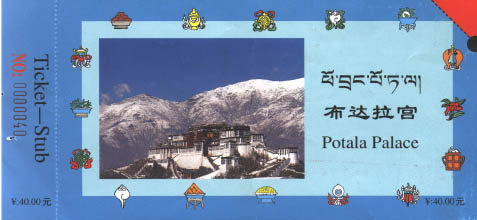 |
|||||
|
Copyright © 2000, Janet I. Egan |
||||||
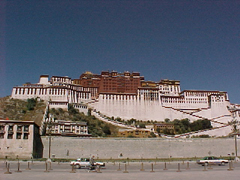 The
Potala! Pinch me, I'm in Tibet! When I think of Lhasa, the
image that comes to mind is the Potala looming over the city
all white and red and huge. I don't think I ever thought
much about what the inside of the Potala looked like.
Certainly I never pictured it jam-packed with Chinese tour
groups on the long National Day weekend. But here it is,
chock full of art treasures and tourists. And stairs.
Thirteen stories of art treasures, tourists, and stairs.
The
Potala! Pinch me, I'm in Tibet! When I think of Lhasa, the
image that comes to mind is the Potala looming over the city
all white and red and huge. I don't think I ever thought
much about what the inside of the Potala looked like.
Certainly I never pictured it jam-packed with Chinese tour
groups on the long National Day weekend. But here it is,
chock full of art treasures and tourists. And stairs.
Thirteen stories of art treasures, tourists, and stairs.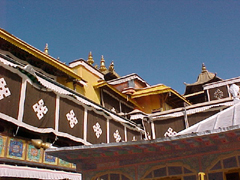 as the blue oxygen pillows. One of those sacks would be
enough butter for an awful lot of lamps.
as the blue oxygen pillows. One of those sacks would be
enough butter for an awful lot of lamps.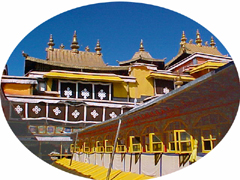 The
Potala was originally built by Songsten Gampo in the 7th
century and expanded to its present size by the 5th Dalai
Lama (The Great Fifth) in the 17th century. The Great Fifth
brought together civil and religious authority for the first
time (uniting church and state as Americans would call it).
This is regarded as a great achievement, hence the
appellation "Great Fifth". George, our guide, would give his
entire speech about The Great Fifth every time we
encountered a statute, portrait, or artifact related to him.
After hearing this speech a couple of dozen times, a light
suddenly went on in my American head and I blurted to Carol:
"The Great Fifth was the inverse Roger Williams!". This of
course meant nothing to George but Carol and I got a kick
out of it. (BTW, The Great Fifth and Roger Williams
were historic contemporaries.)
The
Potala was originally built by Songsten Gampo in the 7th
century and expanded to its present size by the 5th Dalai
Lama (The Great Fifth) in the 17th century. The Great Fifth
brought together civil and religious authority for the first
time (uniting church and state as Americans would call it).
This is regarded as a great achievement, hence the
appellation "Great Fifth". George, our guide, would give his
entire speech about The Great Fifth every time we
encountered a statute, portrait, or artifact related to him.
After hearing this speech a couple of dozen times, a light
suddenly went on in my American head and I blurted to Carol:
"The Great Fifth was the inverse Roger Williams!". This of
course meant nothing to George but Carol and I got a kick
out of it. (BTW, The Great Fifth and Roger Williams
were historic contemporaries.)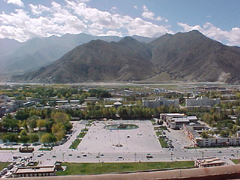 The
view of Lhasa and the mountains beyond from the roof of the
Potala is spectacular. You could easily believe Lhasa is the
center of the world. For all that it maybe is the center of
the world, there were not many westerners among the hordes
of tourists. What westerners we did encounter were
almost
The
view of Lhasa and the mountains beyond from the roof of the
Potala is spectacular. You could easily believe Lhasa is the
center of the world. For all that it maybe is the center of
the world, there were not many westerners among the hordes
of tourists. What westerners we did encounter were
almost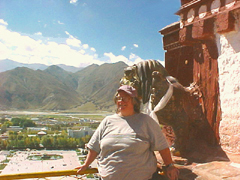 always European or Australian. It was rare to encounter
another American. We ran into some Hong Kong Chinese whom
we'd met on the plane, and they insisted on having their
pictures taken with us. And we saw that lama with the
cellphone whom we'd seen in the airport (he was with the
Hong Kong people) several times.
always European or Australian. It was rare to encounter
another American. We ran into some Hong Kong Chinese whom
we'd met on the plane, and they insisted on having their
pictures taken with us. And we saw that lama with the
cellphone whom we'd seen in the airport (he was with the
Hong Kong people) several times.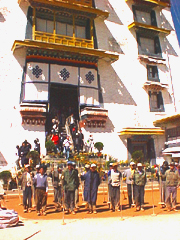 taking
in as much as we could.
taking
in as much as we could.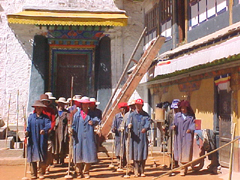 of
cement that I don't remember the word for. And I have no
idea what the lyrics to the cement stomping song meant.
of
cement that I don't remember the word for. And I have no
idea what the lyrics to the cement stomping song meant.